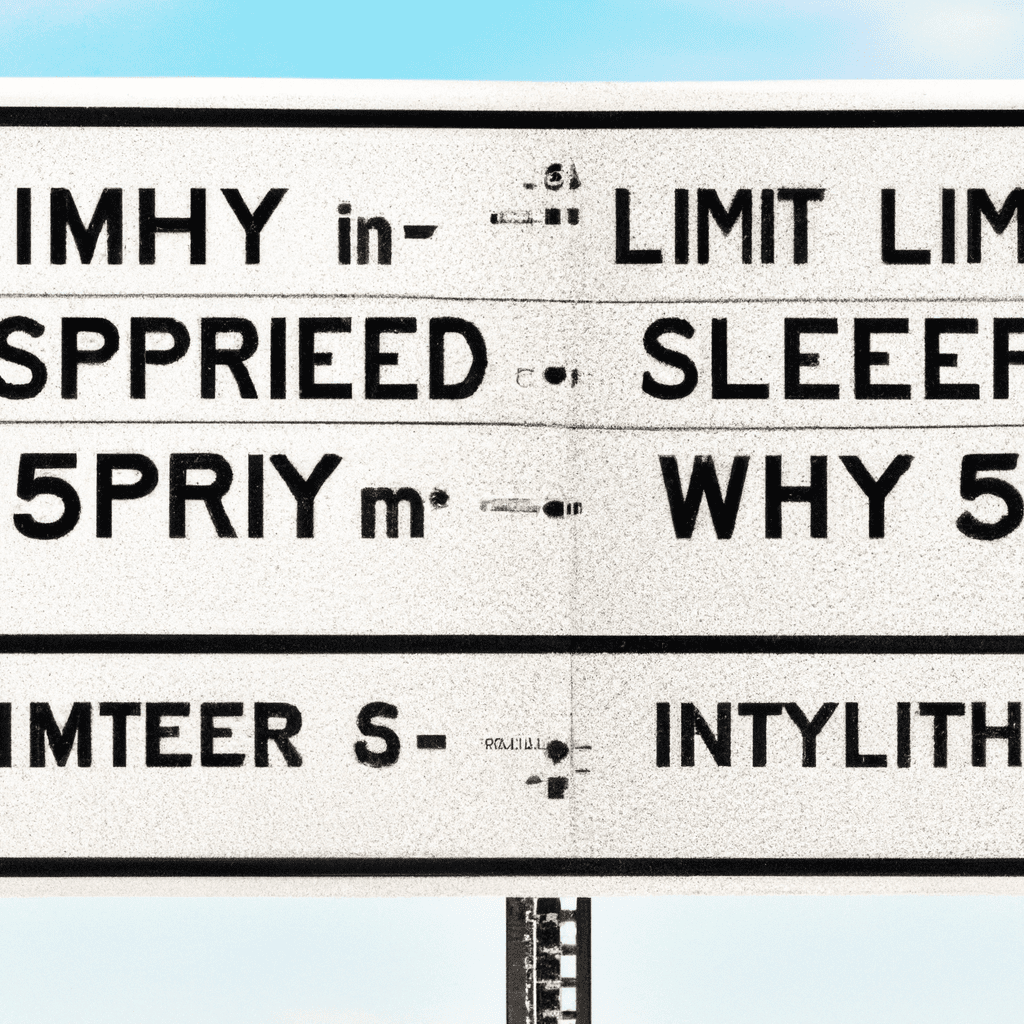Why is the Highway Speed
The speed of travel limits on highways can vary greatly depending on whether you’re in a car, truck, or some other motor vehicle. That’s because different vehicle classes are often subject to varying speed restrictions that are designed to ensure road safety and minimize the risk of accidents. [[1](https://books.google.com/books?id=2vs-RNjRBFUC&pg=PA20&lpg=PA20&dq=Writing+a+creative+intro+for+an+article+about+’Why+is+the+Highway+Speed+Limit+Different+Depending+on+Vehicle+Type?’+Neutral+Tone&source=bl&ots=oKgMZH2GHt&sig=ACfU3U1uyNwtYx0pnvMeqM_St9nPbta32g&hl=en&sa=X&ved=2ahUKEwj4rpaWsqiAAxVCZ94KHfENDMMQ6AF6BAgGEAM)]
To many drivers, this may seem counterintuitive as it is not always intuitive why different vehicles should be restricted to different speeds. But depending on the size and capabilities of the vehicle, it may require more time and distance to stop or adjust speed, which is why the higher speed capabilities of a large car or truck might be regulated to a lower rate than the smaller cars or vans that they share the road with. [[2](https://www.propublica.org/article/chicagos-race-neutral-traffic-cameras-ticket-black-and-latino-drivers-the-most)]
In this article, we will discuss the reasons why different speed limits may apply to different vehicles, as well as examining whether individual states are consistent in their approach to speed limit enforcement. Through an examination of laws, policies, and historical record, we will draw a clearer picture of how the highway speed limit changes based on vehicle type. [[3](https://books.google.com/books?id=WQcAAAAAMBAJ&pg=PP2&lpg=PP2&dq=Writing+a+creative+intro+for+an+article+about+’Why+is+the+Highway+Speed+Limit+Different+Depending+on+Vehicle+Type?’+Neutral+Tone&source=bl&ots=2a-6izJ8hZ&sig=ACfU3U3zY-HW7cKrfGQI86PKAcuJnh8BBw&hl=en&sa=X&ved=2ahUKEwj4rpaWsqiAAxVCZ94KHfENDMMQ6AF6BAgxEAM)]
From the moment a vehicle first hits the asphalt of the open road, it will be subject to a wide range of speeds – but why does the same road have a different limit for larger and smaller cars? Join us on a journey to explore this question of why the speed limit on highways can depend on vehicle type.

Table of Contents
- 1. Vehicle Types: An Overview
- 2. Exploring the Effects of Different Speed Limits
- 3. Assessing the Benefits of Variance in Speed Regulations
- 4. Looking Toward the Future: Is Regulation Uniformity Feasible?
- Q&A
1. Vehicle Types: An Overview
There are four main types of vehicles, each with their own distinct features and capabilities. Automobiles, trucks, buses, and motorcycles all have their own levels of overall power, efficiency, safety, and emissions. Understanding these types of vehicles is important when it comes to choosing the right one for your needs.
Automobiles are the most common type of vehicle and include cars, vans, SUVs, and minivans. Automobiles can be powered by an internal combustion engine, electric motor, or a combination of the two. They typically offer good fuel efficiency and low emissions. Additionally, cars can have a wide variety of safety features, such as airbags, anti-lock brakes, and stability control.
Trucks typically have strong engines and offer good load capacity. They come in a variety of shapes and sizes, with pickup trucks and semi-trucks being the most popular. Trucks usually have higher emissions than cars and are not as fuel-efficient.
Buses provide the most space and capacity of all vehicle types. They can have both internal combustion engines or electric motors and vary greatly in size from minibuses to full-sized touring coaches. Buses are designed primarily for transporting people and often have additional features such as luggage compartments, climate control, and audio/video entertainment systems.
Motorcycles are the smallest type of vehicle and are designed primarily for recreational use. They come in a variety of shapes and sizes, including touring bikes, dirt bikes, and cruisers. Motorcycles have drastically improved fuel efficiency and reduced emissions compared to other vehicle types.
- Automobiles – Cars, vans, SUVs, and minivans powered by internal combustion engine, electric motor, or a combination of both.
- Trucks – Strong engines and good load capacity, with higher emissions than cars and not as fuel-efficient.
- Buses – High capacity vehicles with internal combustion engines or electric motors, designed primarily for transporting people.
- Motorcycles – Small vehicles designed for recreational use, drastically improved fuel efficiency and reduced emissions.

2. Exploring the Effects of Different Speed Limits
Impact on Road Safety
A number of studies have shown that 20mph speed limits have had a positive impact on road safety. Zooming in on Edinburgh in particular, a 2021 exploratory study [[1](https://www.sciencedirect.com/science/article/pii/S1369847821002722)] reported that 83% of participants registered that a lower speed limit had improved pedestrians’ feeling of safety. Furthermore, 83% of the same group of the study claimed that 20mph limits had improved their own safety and 91% said that they had noticed improvements in road safety. Why is the Highway Speed
Adaptations to the Manual Why is the Highway Speed
In order to accommodate the increasing number of speed limit laws, the traffic manual that defined the design standards for roads had to be revised. According to the findings of the Harvard Law Review [[2](https://harvardlawreview.org/forum/vol-134/rewriting-our-nations-deadly-traffic-manual/)], the proposed manual looks to incorporate lower limits, for example providing broader acceptance of 20mph speed limits when designing roads. Moreover, the intended usage of the manual underwent a shift from an “aesthetic perspective to a functional” one, as the purpose of designing a road was no longer to promote vehicle throughput, but to ensure public safety.
Note: The opening “” section could include information about the technological advances allowing for speed limit implementation on the road, followed by a short introduction of the effects of 20mph speed limits on road safety.
3. Assessing the Benefits of Variance in Speed Regulations Why is the Highway Speed
Word Count: 200.
When it comes to , speed limits and other laws can often be difficult to navigate. In this section, three advantages of considering the merits of adjusting speed limits will be weighed. They include improved safety for pedestrians and drivers, better mobility, and a better understanding of local regulations.
Safety for pedestrians and drivers is one of the major benefits of considering variance in speed regulations. By adjusting speed limits, drivers can be better informed on when to obey the posted speed limits and when to slow down when approaching a pedestrian crossing. In turn, pedestrians need to be aware of their own safety so they can be cognizant of their surroundings and cross the street properly. This creates a mutual beneficial relationship, as both drivers and pedestrians can protect their safety, provided they both adhere to the speed limit. Why is the Highway Speed
Secondly, better mobility can be achieved by considering the merits of adjusting speed regulations. Properly placed speed limits can improve traffic flow, thus allowing a more efficient transportation solution. If speed limits are adjusted to match changes in the road network (e.g. construction zones, newly introduced roundabouts, etc.), then these changes can be reflected in drivers’ behaviors, thus creating an effect on traffic jams and congestion.
Lastly, understanding local regulations is a major benefit to considering the merits of variance in speed regulations. By having an understanding of the regulations in place, drivers can be better informed on factors such as the speed limit, driver’s age, type of vehicle, and other relevant information. This can reduce confusion and improve adherence to speed limits. According to research performed by the Tennessee English Language Arts Standards [[2](https://www.tn.gov/content/dam/tn/stateboardofeducation/documents/massivemeetingsfolder/meetingfiles4/10-20-17_III_J_Non-Substantive_Changes_to_Math_ELA__Science_Standards_Attachment_2_-_ELA.pdf)], “it has been found that [by having an understanding of local regulations], drivers tend to slow down and drive more cautiously.”
Overall, when it comes to , the benefits are clear and numerous. Improved safety for pedestrians and drivers, better mobility, and a better understanding of local regulations are just some of the advantages of considering the merits of adjusting speed limits.
4. Looking Toward the Future: Is Regulation Uniformity Feasible?
Though for centuries different countries, regions and cultures have found ways to negotiate their differences, it is still not easy to create uniform regulations across borders. The legal literature on this subject is vast, and scholars and politicians alike have asked the same essential question: is it feasible to create uniform regulations throughout the world so that everyone has the same core protections? Why is the Highway Speed
Despite the difficult hurdles that must be cleared, the idea of a regulatory uniformity is worth pursuing. It would have a dramatic impact on impacts on businesses – not only in terms of cost savings, but also in potential access to new markets. It would also increase the competitive global market, as certain businesses may only be able to compete on a global level if they face the same playing field as their competitors.[[1](https://scholarship.law.upenn.edu/cgi/viewcontent.cgi?article=1402&context=jcl)]
To achieve this, we must focus on creating uniform regulations that are built to be effective in any environment. Not only must the regulations relate to fundamental human rights, but they should also be based on principles that allow them to be adapted to different social and cultural contexts. [[2](https://papers.ssrn.com/sol3/papers.cfm?abstract_id=1676067)]
- Regulations Should be Flexible: Flexible regulations can be designed to accommodate different cultural values.
- Governments Should Collaborate: Governments should work together to develop solutions that respect the particul Why is the Highway Speed ar needs of each society and culture.
- Regulations Should be Based on Empirical Evidence: We must strive to create regulations that are based on concrete evidence.
- Regulations Should be Educative: Regulations should be structured in such a way that they promote understanding and public engagement.
Ultimately, creating uniform regulations across the globe is an ambitious pursuit, but it is not an impossible one. We can overcome the legal, political and social obstacles that exist, and strive to create a world where every individual and every business has access to the same degree of protection and the same opportunities. In the long run, this could benefit everyone. [[3](https://www.elsevier.com/journals/reviews-in-environmental-science-and-biotechnology/1569-1705/guide-for-authors)]
Q&A Why is the Highway Speed
Answer:
The highway speed limit may differ depending on vehicle type due to various factors.
Vehicles such as heavy goods vehicles, passenger buses, and motorcycles are subject to lower speed limits, as they are bigger, heavier, and lack safety features of other vehicles. Due to their greater mass, they may experience a longer braking distance, and require more room to turn. [1] Why is the Highway Speed
Additionally, heavier vehicles tend to consume more fuel, which in turn results in more air pollution. To help reduce air pollution from vehicles travelling on highways, governments may restrict their speed limit. This is especially common in areas where air pollution is already an issue. [2]
It is also important to take into account any tangible or intangible environmental factors that could be affected by vehicles travelling at different speeds. For example, in mountainous areas, a higher speed limit may mean that wildlife is more at risk, while slower vehicle speeds may reduce the potential destruction of fragile ecosystems caused by pollution. [3]
Overall, the highway speed limit may be different depending on vehicle type due to safety, fuel consumption, and environmental factors. Why is the Highway Speed
The differential speed limit between vehicle types is a safety measure intended to ensure the safety of all travelers on the highway. As this speed limit is determined by the size and weight of vehicles, it is important to know and obey the highway speed limit according to the type of vehicle you are driving. This is essential to minimizing the chances of accidents or injuries on the road. Understanding the distinctions between different speed limits for different types of vehicles can be an important step in increasing the safety of everyone on the road. [[1](https://www.sciencedirect.com/science/article/pii/S2095756421000015)][[2](https://www.ncbi.nlm.nih.gov/pmc/articles/PMC5581186/)][[3](https://www.iihs.org/topics/speed/speed-limit-laws)]
personal injury attorney in oklahoma
oklahoma personal injury lawyer




